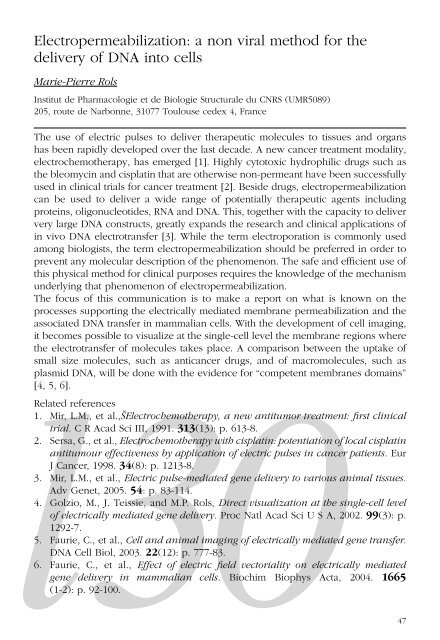Create successful ePaper yourself
Turn your PDF publications into a flip-book with our unique Google optimized e-Paper software.
Electropermeabilization: a non viral method for the<br />
delivery of DNA into cells<br />
Marie-Pierre Rols<br />
Institut de Pharmacologie et de Biologie Structurale du CNRS (UMR5089)<br />
205, route de Narbonne, 31077 Toulouse cedex 4, France<br />
The use of electric pulses to deliver therapeutic molecules to tissues and organs<br />
has been rapidly developed over the last decade. A new cancer treatment modality,<br />
electrochemotherapy, has emerged [1]. Highly cytotoxic hydrophilic drugs such as<br />
the bleomycin and cisplatin that are otherwise non-permeant have been successfully<br />
used in clinical trials for cancer treatment [2]. Beside drugs, electropermeabilization<br />
can be used to deliver a wide range of potentially therapeutic agents including<br />
proteins, oligonucleotides, RNA and DNA. This, together with the capacity to deliver<br />
very large DNA constructs, greatly expands the research and clinical applications of<br />
in vivo DNA electrotransfer [3]. While the term electroporation is commonly used<br />
among biologists, the term electropermeabilization should be preferred in order to<br />
prevent any molecular description of the phenomenon. The safe and efficient use of<br />
this physical method for clinical purposes requires the knowledge of the mechanism<br />
underlying that phenomenon of electropermeabilization.<br />
The focus of this communication is to make a report on what is known on the<br />
processes supporting the electrically mediated membrane permeabilization and the<br />
associated DNA transfer in mammalian cells. With the development of cell imaging,<br />
it becomes possible to visualize at the single-cell level the membrane regions where<br />
the electrotransfer of molecules takes place. A comparison between the uptake of<br />
small size molecules, such as anticancer drugs, and of macromolecules, such as<br />
plasmid DNA, will be done with the evidence for “competent membranes domains”<br />
[4, 5, 6].<br />
l30<br />
47<br />
Related references<br />
1. Mir, L.M., et al.,[Electrochemotherapy, a new antitumor treatment: first clinical<br />
trial. C R Acad Sci III, 1991. 313(13): p. 613-8.<br />
2. Sersa, G., et al., Electrochemotherapy with cisplatin: potentiation of local cisplatin<br />
antitumour effectiveness by application of electric pulses in cancer patients. Eur<br />
J Cancer, 1998. 34(8): p. 1213-8.<br />
3. Mir, L.M., et al., Electric pulse-mediated gene delivery to various animal tissues.<br />
Adv Genet, 2005. 54: p. 83-114.<br />
4. Golzio, M., J. Teissie, and M.P. Rols, Direct visualization at the single-cell level<br />
of electrically mediated gene delivery. Proc Natl Acad Sci U S A, 20<strong>02</strong>. 99(3): p.<br />
1292-7.<br />
5. Faurie, C., et al., Cell and animal imaging of electrically mediated gene transfer.<br />
DNA Cell Biol, 2003. 22(12): p. 777-83.<br />
6. Faurie, C., et al., Effect of electric field vectoriality on electrically mediated<br />
gene delivery in mammalian cells. Biochim Biophys Acta, 2004. 1665<br />
(1-2): p. 92-100.
















